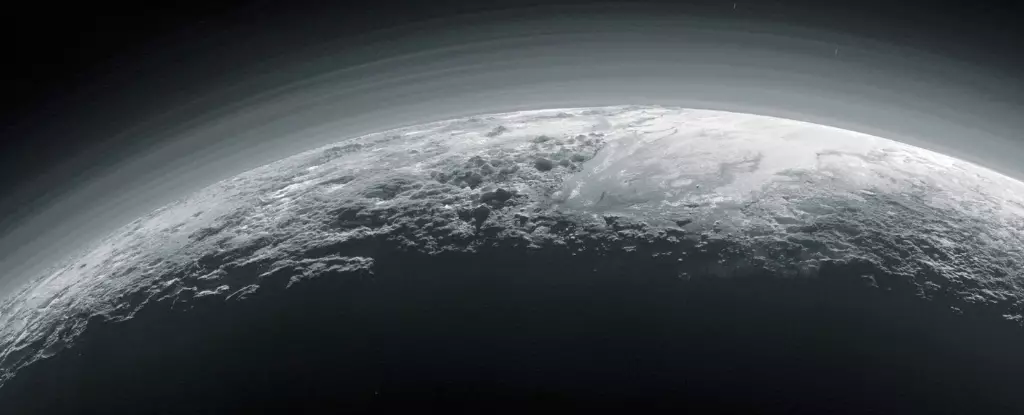In July 2015, the world held its breath as NASA’s New Horizons spacecraft made its historic flyby of Pluto, illuminating our once-illuminated understanding of the icy dwarf planet and its largest moon, Charon. This unprecedented encounter unveiled a complex world marked by intriguing geological features and a previously unknown active atmosphere. Fast-forward to the present, the James Webb Space Telescope (JWST) has provided astronomers with a stunning opportunity to delve deeper into the enigmatic atmosphere of Pluto, revealing astonishing findings that challenge our previous notions and shake the foundations of planetary science.
Recent observations from the JWST, taken during 2022 and 2023, present a groundbreaking perspective on Pluto’s atmospheric composition. This revelation identifies a unique haze—a concoction of nitrogen, methane, and carbon monoxide—that behaves unlike anything else found within our Solar System. The particles in this haze exhibit a remarkable ability to rise and fall in response to temperature fluctuations, playing an instrumental role in controlling the energy dynamics of Pluto’s atmosphere. This distinctive behavior sets Pluto apart from its celestial neighbors, igniting new conversations about atmospheric processes beyond our planet.
The Hypothesis That Changed Everything
The conceptual leap to explore the dynamics of Pluto’s haze began with astronomer Xi Zhang at the University of California—Santa Cruz. In 2017, Zhang proposed the idea that if the haze had a cooling effect on the planet, it would likely be emitting strong mid-infrared radiation—an audacious hypothesis that many may have dismissed as overly ambitious. However, in a scientific community that often experiences lengthy timelines for validation, having such a theory affirmed within just a few years marks a significant milestone. Tanguy Bertrand, leading a team from the Observatoire de Paris, capitalized on this hypothesis, utilizing the JWST’s capabilities to scrutinize the atmospheric conditions and haze effects on Pluto.
The results affirmed Zhang’s predictions, highlighting the importance of theoretical models in aiming for experimental validation. As Zhang remarked, “We were really proud, because it confirmed our prediction.” Statistically significant confirmations of hypotheses in planetary science are rare; this underscores the value of meticulous, innovative thinking in unlocking cosmic secrets.
Revisiting Pluto and Charon’s Atmospheric Conditions
As researchers accumulated data, they were drawn to the dichotomy between Pluto and its moon Charon. While Pluto’s atmosphere is brimming with active chemical dynamics, Charon exists in stark contrast, displaying little to no atmospheric presence. Observations made during the New Horizons mission revealed that Pluto’s haze not only acts as an active laboratory for nitrogen and methane photochemistry but also hints at seasonal outgassing phenomena occurring on Charon. These insights illuminate a broader understanding of the celestial mechanics at play, suggesting that the interaction between these two bodies forms an intricate relationship that warrants further investigation.
The capabilities of the JWST allowed scientists to refine their focus, specifically analyzing Pluto’s atmospheric data through the MIRI instrument. The emitted thermal radiation data captured spectra across various wavelengths, establishing a clearer understanding of the atmospheric and surface conditions. In a bold demonstration of scientific rigor, these observations revealed fluctuations in surface temperatures and thermal emissions on both Pluto and Charon—enabling researchers to effectively map the complexities of heat distribution across the two worlds.
Unique Insights and Implications for Planetary Science
The revelations about Pluto’s atmosphere have far-reaching implications, not just for our understanding of this particular dwarf planet but for planetary science as a whole. The revelations indicate that haze particles—rather than gas molecules—primarily control the energy equilibrium of Pluto’s atmosphere. This challenges many established beliefs surrounding atmospheric physics in celestial bodies, leading researchers to reconsider and reevaluate similar processes on other planets.
Zhang’s reflections on these findings evoke a sense of excitement not just in the discovery of new phenomena, but also in the potential insights they could offer about the early conditions of Earth’s atmosphere. “By studying Pluto’s haze and chemistry, we might gain new insights into the conditions that made early Earth habitable,” Zhang proposes—a riveting idea that connects distant worlds to our planetary origins.
This momentous era of atmospheric exploration goes beyond Pluto; it invites an examination of other celestial bodies exhibiting similar haze phenomena, such as Triton and Titan, pushing the boundaries of our understanding of planetary atmospheres.
Through a combination of innovative technology, bold hypotheses, and interstellar curiosity, humanity stands on the brink of unveiling new layers of complexity in our Solar System. The full potential of these findings is yet to be realized, yet they reflect humanity’s enduring quest to comprehend the intricate tapestry of the cosmos and our origins therein. The unprecedented data from Pluto’s atmosphere beckons future research, setting the stage for a deeper exploration that may yield transformative insights into our universe.


Leave a Reply